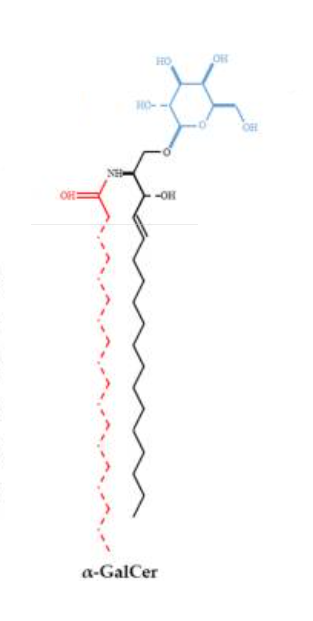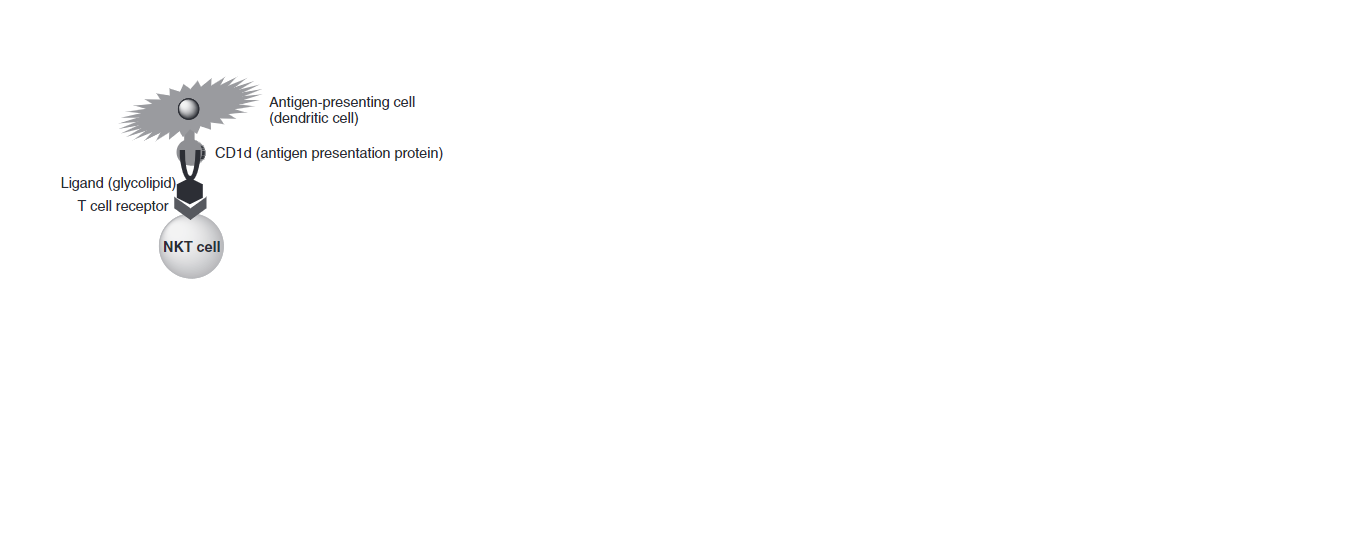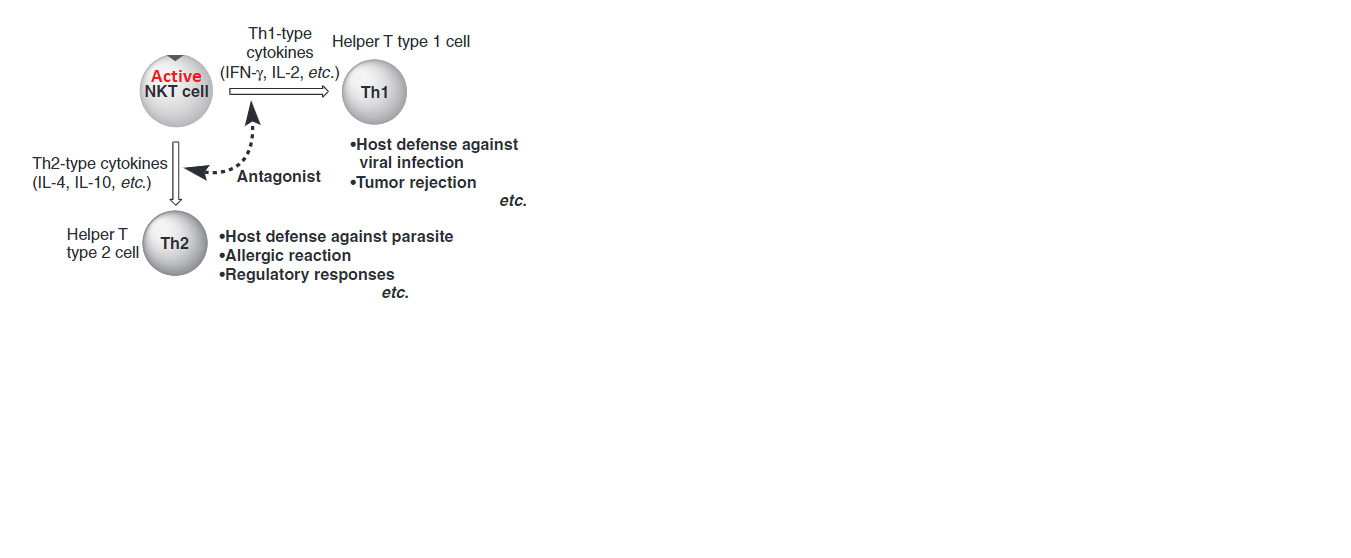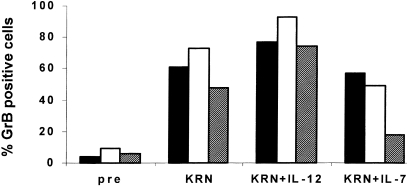KRN 7000, is also known as α-galactosylceramide (α-GalCer). It is a synthetic glycoprotein i.e., having chemically bonded carbohydrate and lipid part (specifically sphingolipid). Its structural formula is diagrammatically shown in Figure 1, while the different components of KRN 7000 are highlighted in the Figure 2. Keep in mind that both the structures in Figure 1 and Figure 2 are of KRN 7000. Apart from its native structure, several structural analogies to the KRN 7000 have also been synthesized by incorporating a little bit changing to the main structure. One of the major change sites for these analogies is sixth carbon of the main carbon backbone. One of the different functional groups, for example deoxy-, thio- or amino- group, can be substituted in these analogies of KRN 7000. By adding these substitutions, more active/ functional can also be attached like cathepsin B. Cathepsin B is a linker having ketone group which facilitates the peptide conjugation. In this way, the efficiency of the KRN 7000 based vaccines has been improved (Meijlink et al., 2022). Different mechanisms and steps involved in the synthesis of KRN 7000 have been deeply discussed in the published literature so far.

Figure 1 Structure of KRN 7000

Figure 2 A description of the Structure of KRN 7000: Blue region is a polar head group, Black region is sphingosine backbone, and Red region is the fatty acids
It can act as an immunomodulator (Dossa et al., 2015) as it affects and regulates the immune system/ responses, thus can be proven as the most effective anti-cancer or anti-tumor compound (pharmaceutical agent/ drug). Another best possible solution for the anti-drug effect is fenretinide (Companioni et al., 2021). It may be used as in novel cancer immunotherapy in near future. It does this by activating the Natural Killer T (NKT) cells (a type of cells of immune system, specifically, invariant NKT cells, which are a sub-category of NKT cells), when presented to them. Natural Killer T (NKT) cells belong to a much broader category of T cells (Webb et al., 2020) and considered as a borderline between two major domains of immune system, namely, the innate and adaptive immune system. CD1D is a presentation protein that can present any ligand to the NKT cells, which has either lipid antigen or peptide antigen (Van Der Vliet et al., 1999). CD1d glycoprotein molecules on the surface of the antigen presenting cells, present KRN 7000 to the NKT cells. In this presenting, the lipid part of the KRN 7000 acts as lipid antigen. The NKT cells have a specialized receptor, named as T Cell Receptor (TCR), which recognizes the lipid antigen being presented. This whole presentation process is diagrammatically illustrated in the Figure 2.

Figure 3 All the components involved in Presentation of KRN 7000 to the NKT cell
Activated NKT cells initiate the generation of cytokines(specifically, Interferon gamma) in the Cytotoxic T lymphocytes (CTLs) and immune cells, which would be affecting other immune cells. These cytokines include both Th1 cytokines and Th2 cytokines, are simultaneously generated. Th1 cytokines activate the Helper T cells type 1 while Th2 activates the Helper T cells type 2. Examples of Th1 cytokines are Interferon gamma and Interleukin 2, while the examples of Th2 cytokines are Interleukin 4 and interleukin 10. Providing defense/ immunity against pathogenic infections, especially viral ones and rejecting the cancerous cells are the primary functions of the active Helper T cells type 1. On the other hand, providing defense/ immunity against pathogen infections, especially the parasitic ones, causing the allergic reactions and regulatory responses are the primary functions of the Helper T cells type 2. The roles of an active NKT cell are summarized in the Figure 1.

Figure 4 The relationship among the functions of the NKT, Th1 and Th2 cells is diagrammatically presented, once they become active. Active NKT cells have all the components as illustrated as Figure 1, but not shown here for keeping the diagram simple.
The interesting point is that the simultaneous activations of Th1 and Th2 are antagonistic in nature, that means that if both Th1 and Th2 are activated at the same rate. There would be no resultant effect, and neither of the above-mentioned roles would be performed. In other words, both the activation would completely block each other. The anti-cancer or other functions supporting the immune system (which are previously mentioned) would only be possible or evident if there exists an imbalance between the activations of Th1 and Th2. That simply means, either Th1 or Th2 activation rate must be higher to show some resultant beneficial effects on the cancer state or just on the immune system. Also, this same antagonistic relationship between the activation of Th1 and Th2 is a major hurdle that come across in the potential use of KRN 7000 as an anti-cancer drug (Tashiro, 2012).
These cytokines have the anti-cancer or anti-tumor affect/ function, especially against secondary cancers of liver, skin, colon and sarcoma in mice. NKT cells also regulates some of the major autoimmune diseases. The main anti-cancer affect includes inhibition of the tumor growth which is associated with the high production of M1 Macrophages in the tumors (Paul et al., 2019). Several animal models, especially murine models, have been developed to investigate and predict the role of KRN 7000 in Human body. A study has shown that vaccination containing KRN 7000 for mice, has shown positive outcome. It must be noted that KRN 7000 can only be anti-cancer in the presence of NKT. Also, KRN 7000 can activates the invariant NKT cells of human.
In addition to the instinctive anti-cancer effect that the invariant NKT cells have, they also regulate the functions of different lymphocytes, for example, B lymphocytes and Large Granular Lymphocytes (LGL) and Cytotoxic T lymphocytes (CTLs), etc. and cells of innate immune system, for example, neutrophils and macrophages. This regulation is accomplished as they secrete cytokines which cause inflammation, i.e., the first body response to any foreign particle/ cell. … Both Neutrophils and macrophages, secretes the lytic enzymes, predominantly proteases which kill the foreign particles/ cells or pathogens and followed by the phagocytosis of their debris.
KRN 7000 also causes the upregulation (statistically significant, which was shown by the p-value as 0·0135) of Granzyme B in the targeted cell (primarily the cancer cells) which is a protease at the serine residual amino acid. This protease causes the complete destruction of the structural as well as functional proteins of the cancer cells and leading to their death via apoptosis, a mechanism of programmed cell death (Van Der Vliet et al., 1999, Andrade et al., 2004). This is also called as cytotoxic effect. Similar results can also be achieved by perforin instead of Granzyme B .

Figure 5 The Amount of Granzyme B in the cell loaded with KRN
Although, it has been investigated that anergy is caused owing to repeated exposure to KRN 7000. However, it has also been discovered that loading dendritic cells (DC) with KRN 7000 can potentially nullify that anergy (Webb et al., 2020). This loading of DCs can be done through various methods, e.g., using nanovectors, nano-particle based delivering system and exosomes having KRN 7000.













Kommentare